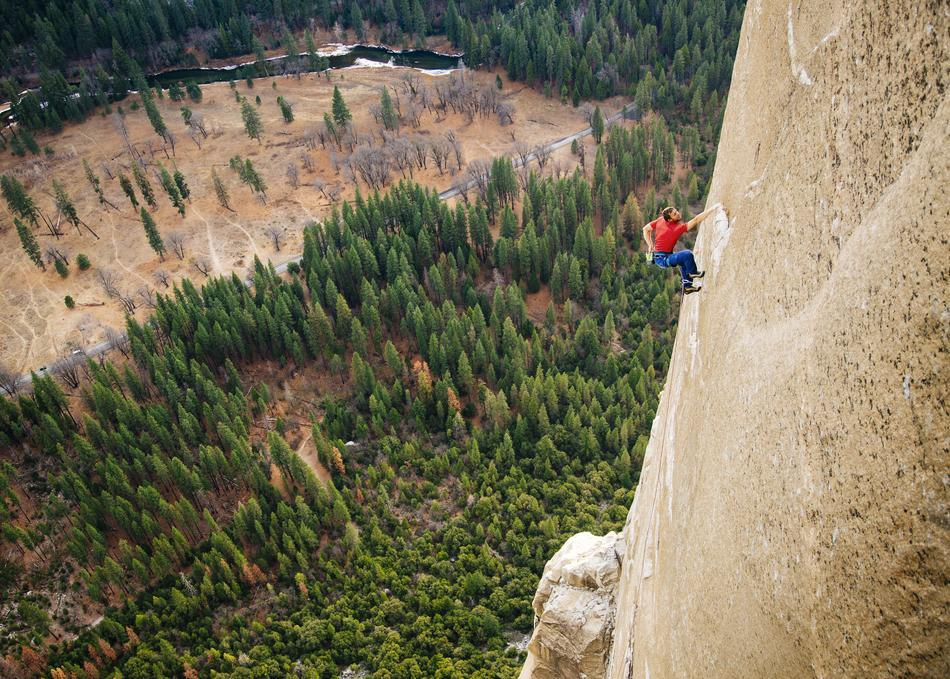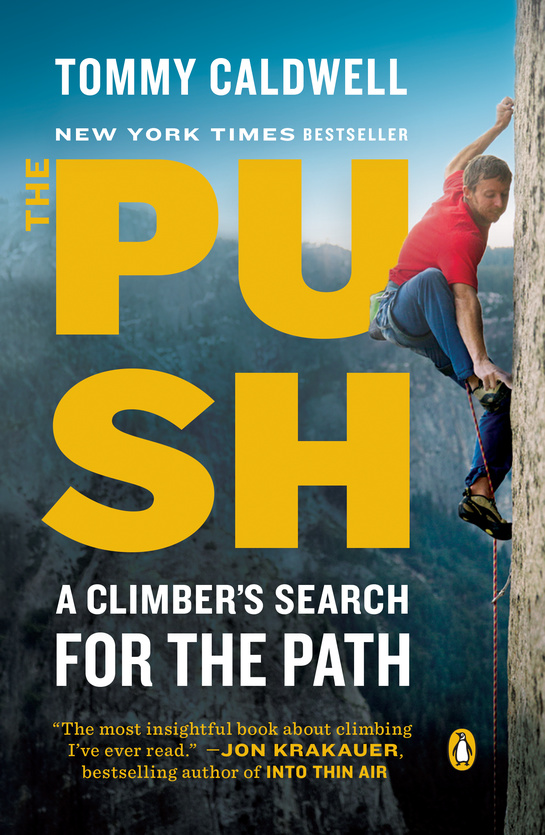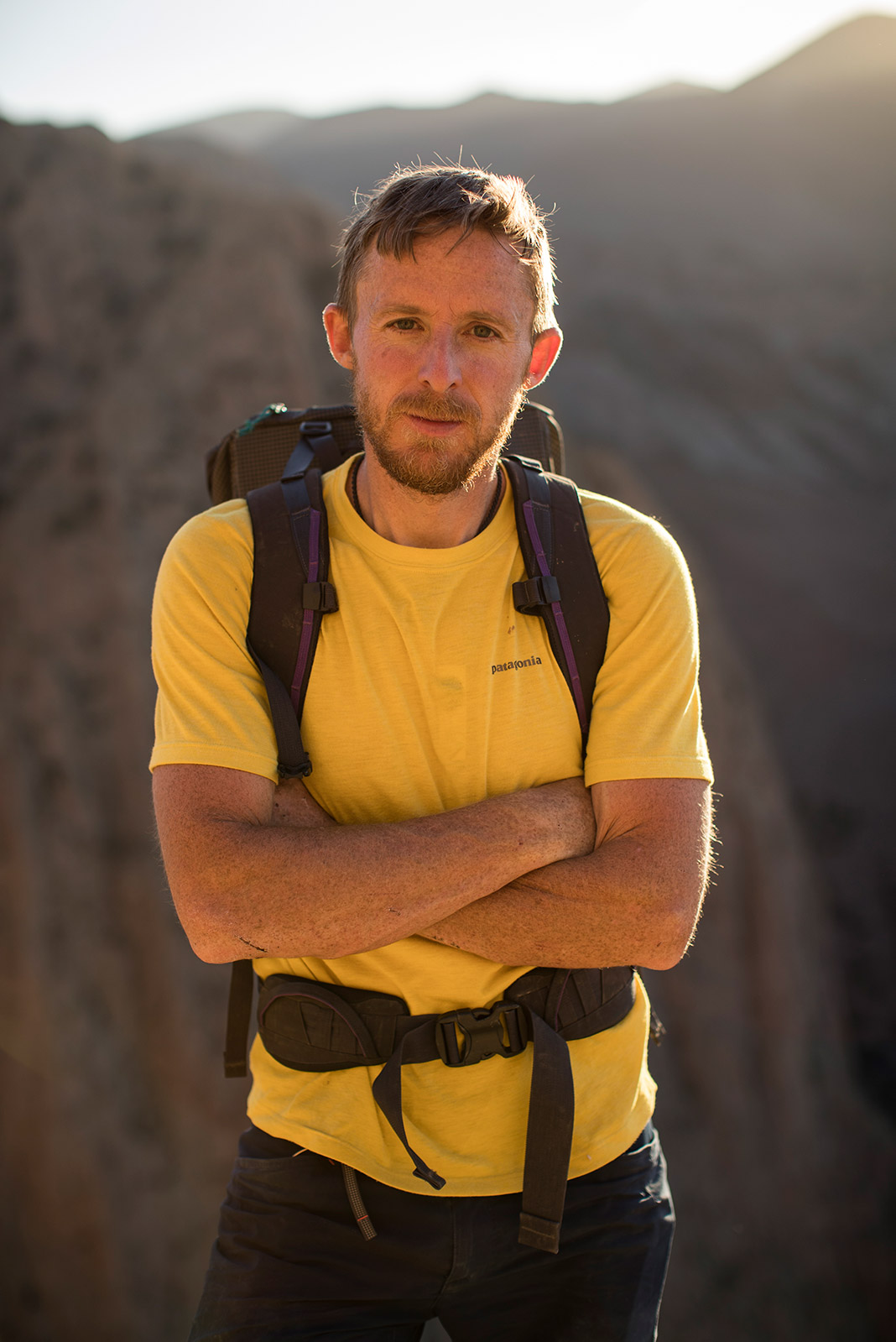
At 3 years old, most of us are practicing dressing and feeding ourselves, working on improving our 300-or-so-word vocabulary, and having play dates. For Tommy Caldwell, age 3 was also when he started climbing big rocks with his father in Estes, Colorado. It is a pursuit that stuck. Now Caldwell is widely considered one of the best climbers in the world, with his most outstanding achievement to date being one of the first people — along with partner Kevin Jorgeson — to free climb infamously smooth Dawn Wall on Yosemite’s El Capitan in 2015. It was an achievement eight years in the making that Caldwell captures grippingly in his best-selling book The Push: A Climber’s Search for the Path, which he’ll be discussing this Wednesday, May 16, at UCSB’s Campbell Hall. I recently spoke with Caldwell over the phone from his home in Colorado about his life as a climber, writing his book, and how his life has changed since his Dawn Wall feat.

I read your book, The Push: A Climber’s Search for the Path, and found it fascinating. You really bared your soul. I was quite impressed. How was writing about such intimate details of your life?. It was [a cathartic] process for me; that was half my reason for writing the book — [it] was like, personal therapy, really. And I feel like memoirs, they just aren’t good unless people do that generally. I feel like that’s pretty crucial. I’m really glad that I wrote it that way, and …
It must have been tough reliving some of those memories. And then also the detail that you had on your climbs was so impressive. Do you keep journals? I don’t journal that much, honestly. Some of the more recent detail was with social media; social media posts are kind of like a journal, like a modern-day journal. For the older stuff, I’d go back and revisit these [places] sometimes. I’ve been climbing my whole life, so I know a lot of the feelings, the smells; these memories are pretty distinct in my mind still.
I have a cold and I was wondering if I’d be able to manage a phone interview, and then I remembered the bit in your book about how sick you got while climbing the Dawn Wall and thought, “How the heck do you keep climbing when I’m debating if I can even make a phone call?”. Adrenaline can overcome that sort of illness, and [weight loss is] really good for climbing.
Less to haul around?. Yeah, you get a little bit better strength-to-weight ratio, so you just inevitably lose weight when you live on a wall for that long. That had to be one of the reasons that Kevin [Jorgeson] managed to do the climb in the end — he stayed up there long enough that he lost a lot of weight. It’s not a good long-term strategy, but for building strength, in this really brief window, it could actually be helpful.
So you lose the weight, but you don’t lose strength? You don’t feel great when you’re just hanging out, but when you’re climbing, you feel quite light. I think operating on less calories — I feel like there’s science behind that, it helps you focus a bit, a bit of a survival instinct kicks in.
You don’t seem like you have much trouble focusing. Yeah, generally, I focus pretty well, but there are different levels, and to get in that real slow state where you kind of feel the transcendence, it’s like a new level of focusing.
Do you have another big climb like the Dawn Wall on the horizon? I’m always climbing. Climbs like the Dawn Wall don’t come around every day…. I do always have my ears open and eyes open for more big projects like that, but generally I just do my normal climbing, which is five days a week, traveling all over the world, some expedition stuff, more local stuff …. If I find something that moves me to become really focused, I will do that. For the last few years, it’s been a little bit more about raising a family …. And I wrote the book, and a film just came out based on the book, so it’s been a little bit more like that …. Soon [I’m] going on the road with the family for a whole year, moving into our van next year, renting out our house.
Traveling the United States?. We’ll probably spend three or four months in Europe, but a lot of time in the U.S., too. Van life is such a great way to bond with the family. You work together. You are really together, and so we want to do that before the kids go to school.
How has life changed for you since you the Dawn Wall climb? My life did change quite a bit after the Dawn Wall because of the opportunities that arose — which is both good and bad. It’s taken me out of the battle more than I prefer, but it’s also created a lot of opportunities. I do a lot of nonprofit fundraisers … where I travel and speak to some group or another. I also wrote the book, so it’s like a bit more of an office job. [Laughs.] There are times in life for everything, and in general, I love what I do.

Climbing has become popular in a way that it wasn’t when you were starting out. It’s exploding in popularity. It’s growing really fast. The Olympics have a big part to do with that; it’s going to be in the next Olympics. Indoor climbing is seen as sort of spurring this change. The high-end [climbers] are focusing more on indoor climbing and getting way more scientific. Everybody has trainers now — I’ve never had trainers — and coaches. There are major climbing gyms being built in every city, which is cool …. because I think that that’s going to filter up to the more adventurous [climbs]. Like the gene pool’s going to be tapped and people are going to figure out how to get really strong. Some of them are going to go to big walls, and that’s going to be really cool to see. [Also, it is] creating an economy; the fact that I can make a living and support my family off of climbing was unheard of a decade ago. So that’s really cool.
What do you think was the tipping point for climbing’s popularity? Because now you’ve got people such as Alex Honnold — and yourself — who are famous? I think it was combination of things. Part of it was just that people figured out that climbing as a fitness tool is just far superior … you can do it in any major city now; you go to a climbing gym. And it’s just way more fun than going to run on a treadmill or something. Plus, there’s a community element to it. There’s that adventurous side. People can dream about the adventure. So just more and more people are realizing that it’s not just a sport for thrill seekers and adrenaline junkies. It’s a lifestyle sport; it’s a family sport …. But the realization of that, that it’s more than just a sport, has a little bit to do with people like Alex Honnold, and even the story of the Dawn Wall. A lot of people started climbing because of the fact that it’s in the news these days, and it creates the best stories. … People tend to obsess about climbing. They make their lives about some pursuit, and that makes a really great story.
Your book was helpful to me, too, to understand the sport of climbing because I had considered it an adrenaline junkie’s sport. When I read about the safety measures that go into each climb and saw videos of your ascents, I could see it’s a lot safer than it appears.. It’s a lot more safe than logic tells you it should be …. Human instinct makes you think, “This shouldn’t work. You shouldn’t be thousands of feet off the ground falling through the air. You’ll die.” But technology has made it so you can. For me it’s a medium, because I think some humans have this warrior instinct built into them, but it’s really hard to exercise that in today’s world. You don’t need to, necessarily. So climbing does that. I feel that adventure, but it’s safe. … [Although] you can make it dangerous for sure.
Do people ask you if you are an adrenaline junkie? Less now, actually, because people are understanding climbing for the first time.
In The Push you write about finding miniscule bits of surface roughness that allow you to climb. For example, you are putting your foot on a pea-sized nubbin, basically, and that is truly what is holding you up while you take your hands off the wall and then put them somewhere else to move upward. That pea-sized nubbin and your strength is the difference between climbing the wall and not climbing the wall.. Yeah, I find that process fascinating because it’s about mastery. Mastery’s an addicting thing if you ever have the chance to really dive that deeply into something and do something that doesn’t seem like it should work. That’s really pretty invigorating. Learning to climb on such small holes, it feels magical when it works.
It’s an interesting combination of focus and obsession. Are those the personality trait through-threads that all climbers have? I think they’re just passionate people, and climbing is this incredible conversation with the places that you are. If you go to a national park and you climb on the rocks, you’re going to have a very different experience than if you just go and look at them from afar and then leave. We spend months, we get to know them, we fall in love with them; it’s this relationship. So you get in this community of people that have experienced that, and they’re energetic people. They’re really fun people. I really think climbing becomes the venue, and it’s addicting for all the reasons we’ve talked about, but really, the thing that makes it a lifelong sport for most people … it’s the family, the tribe.
And then all that time in nature. Yeah, it feels spiritual. The other side of it is when you can’t do that, you get quite grumpy. [Laughs.]
What do you do when you’re grumpy? I live in the mountains, so I can run out my back door and run up some mountain or something and then come back in a much better mood.
From the five minutes on the phone with you, I’d say you seem well-adjusted, cheery, and fun. I’m pretty positive. It’s a great annoyance to some people.
I think you’d have to be to get through some of the things you’ve experienced — being kidnapped, lopping off your finger. You have a pretty intense base of comparison. I think my positivity and enjoyment is a direct result of seeing the darkness. I have this ability to zoom out when I’m getting a little grumpy and think, “Really, it’s not as bad as this circumstance.” And then I travel all the time, too, and that tends to do that to you.
What’s your discussion at Santa Barbara going be about?. It’s a book presentation, essentially. I’ll show slides, show video footage, do some readings from the book … It should just be a fun night. I’ll tell inspirational stories, try and spread the excitement.
When’s The Dawn Wall film coming out? The film premiered already at the South by Southwest Film Festival in Austin, Texas. It won Audience Choice Award. It was awesome, pretty exciting. I think it’s going do the festival tour for the next few months, then from there it’ll do a theatrical run of some sort, but it’s not totally defined. People will definitely have a chance to see it [though].
411
As part of its National Geographic series, UCSB Arts & Lectures presents an evening with climber Tommy Caldwell, Wednesday, May 16, 7:30 p.m., at UCSB’s Campbell Hall. Call (805) 893-3535 or see artsandlectures.ucsb.edu.



